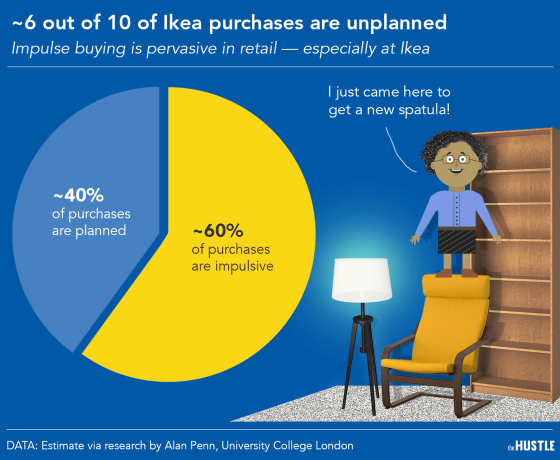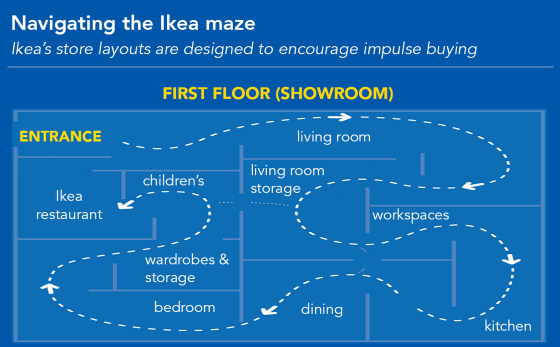What is IKEA's strategy for inducing impulse purchases?

by
The IKEA store displays a huge number of items on a vast site, and I had the experience of 'picking up items other than the ones I was looking for and putting a lot of items in the cart by the time I lined up at the cash register.' There should be many people. Business media The Hustle explains the strategies IKEA is using to get its customers to buy more.
How Ikea tricks you into buying more stuff
https://thehustle.co/how-ikea-tricks-you-into-buying-more-stuff/
Alan Penn, an economics researcher at University College London, analyzes that 60% of the goods bought at IKEA are on impulse purchases. IKEA's creative director also said , 'Only 20% of the items purchased at IKEA are based on actual needs.' The Hustle explains how IKEA works to induce such a large amount of impulse purchases.

◆ Store layout
Companies typically use layouts that allow customers to explore the store on their own initiative. These stores have the characteristics of 'easy to understand the floor plan,' 'easy to reach the desired item,' and 'high list of items,' and customers can move around the store in any order and pick up the items. You can take it.

However, IKEA has a winding route on an average of 300,000 square feet (equivalent to five soccer fields), and customers need to keep walking in order to reach the desired item. I have. According to The Hustle, customers going to IKEA need to walk about a mile.

By setting up complex routes as described above, IKEA has
In addition to complicating routes, IKEA has devised store designs such as installing mirrors in showrooms to give customers the feeling that they belong to the showroom, and installing wagons packed with a large amount of inexpensive products. I am doing.
◆ Setting decoy price
At IKEA, we are adding half-finished quality and priced items to our lineup in order to sell more items. For example, if you want to sell '$ 40 shelves made of cheap materials' and '$ 80 shelves made of premium materials', IKEA will buy '$ 70 shelves made of cheap materials'. It will be added to the lineup. Studies have shown that adding these half-priced items can increase sales by 14%.

◆ Efforts to keep prices low
The reason why IKEA is so popular is also the cheapness of the goods. At IKEA, we are developing products based on the philosophy of 'prioritizing price and designing later', and it is also known to actively reduce the prices of products that have been launched.
For example, the long-selling chair ' Poäng ' at IKEA was sold at the current value of about $ 340 (about 39,000 yen) in 1994, but at the time of writing the article it was 12,990 yen. It is sold at less than half the price.

One of the reasons IKEA can offer goods cheaply is the packing method. IKEA furniture is basically prefabricated and is disassembled and stored in a flat box at the time of sale. This packing method is called 'flat packing' and helps reduce transportation costs and improve storage efficiency.
◆ IKEA effect
As mentioned above, IKEA sells furniture in disassembled form, and customers must bring the furniture home and then assemble it themselves. At this time, it is known that the effect of 'feeling that what you make is valuable' works.
The above effect is that 'the group that folds origami by yourself' gives a higher price to the work in 'the group that was given the origami of the finished product' and 'the group that folds

◆ Food court
At relatively large IKEA stores, there are two types of food courts, one with hundreds of seats where you can enjoy Swedish meals and the other with food courts where you can enjoy light meals such as hot dogs. These food courts are IKEA. It generates about 2.4 billion dollars (about 277 billion yen) of annual revenue, which is equivalent to 5% of the total revenue of IKEA.
A 2012

Related Posts:
in Note, Posted by log1o_hf







